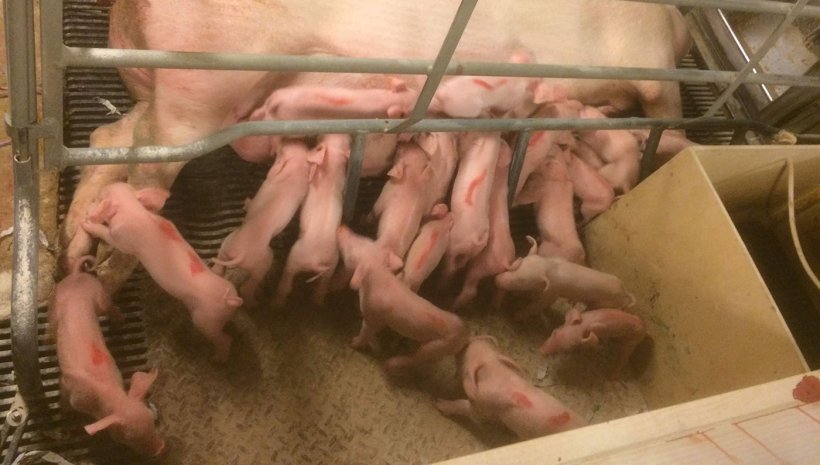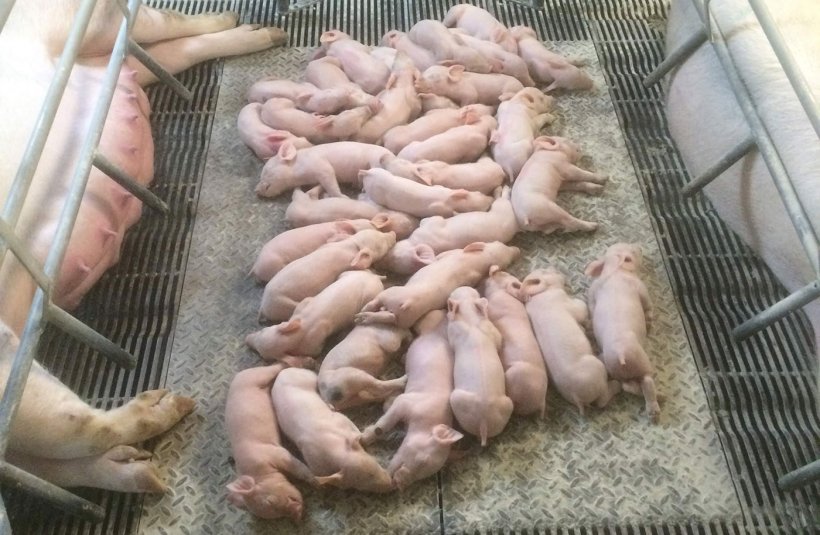The better we carry out the fostering process, and the management in general during the first 24-48 hours of life, the less work we will have to do afterwards and the better results we will obtain.
In order to do fostering successfully, it is essential to start with a piglet that has excellent vitality. One requirement I consider fundamental is prohibiting farrowing induction. Nowadays, gestation is longer, with averages over 116.5 days, and it varies between sows. When inducing we can see piglets with good weight, but with less vitality.

Maximize colostrum production:
Clearly, the sow's feeding plan is fundamental, but one beneficial practical tip is to administer oxytocin at the end of farrowing. On the one hand, it helps expel the placenta, but more importantly, it increases and lengthens colostrum production. It is interesting to combine this with the next step.
Ensure colostrum intake:
No piglet should be moved before it has had a proper intake of colostrum. This means about 24 hours with the mother, with a non-negotiable minimum of 12 hours (that is, the umbilical cord must be perfectly dry). To allow a good colostrum intake, some piglets are separated out. One criterion before transferring the piglets would be that three turns have been made: separating out the large piglets twice and the small ones once. Ideally, the oxytocin injection should be combined with confining the large piglets to let the small piglets take advantage of the increased colostrum letdown.

Marking colostrum intake
Plan fostering- count sows and count piglets:
In this area we can consider more or less criteria Ideally, one should start by evaluating the sow's history, functional teats, body condition, etc. The objective is to achieve litters that are uniform by size, with piglets that have good colostrum intake and vitality so that competition between them is balanced and to stimulate and take full advantage of the sow's milk.
Matching: if we see it as a game, it's like a puzzle
where we must place the piglets with the sows.
Processing:
Here we must distinguish between iron and teeth grinding and the rest of the procedures. The iron must be administered as soon as possible because the piglet needs it to have an optimal start; it can be done as pigs are handled for fostering. Teeth grinding must be done before cross-fostering to ensure that the piglets do not injure any teats or each other when fighting, which could introduce infections and cause problems. I prefer to do teeth grinding rather than clipping. It is better to delay the rest of the procedures (if tail docking or administering some product) until 3-4 days of life so as to not interfere with the start of lactation.
Place two piglets more than the sow has teats:
Obviously we are talking about farms with high prolificacy, exceeding 18 born alive. At the beginning of lactation, the sow produces much more milk than the piglet can drink, much more still if the piglets are small. This lack of complete emptying of the mamary glands tends to limit their production. The greater the stimulation, the greater the present and future milk production of the sow. In addition, at first, piglets cover an area of the udder rather than a specific teat.
Continual monitoring of the piglets:
Twice a day, piglets should be checked and we should mark the piglets that we see are not progressing. This supervision is essential if we are placing a large number of piglets on the sow, because a piglet that is falling behind can be lost in a few hours.
Take full advantage of gilts:
Young sows should have the best performance and it is important that their first lactation be excellent in order to maximize the number of functional teats and the milk production. We will place two, or even three more piglets than teats and propose that gilts have lactations of at least 23-24 days.
Creation and selection of nurse sows:
When we reach 15 piglets marked for falling behind the rest of the litter, we put them together on a nurse sow. When establishing nurse sows, I prefer to minimize the steps for both sows and piglets so, if possible, I look for a sow about to be weaned to be a nurse sow. The criteria for choosing the sow are: that she has a good feed intake, a good body condition, that she has had a good lactation, and that her litter was uniform. In my experience, with a prolificacy of 18.6 BA, we plan to leave 20% of farrowing pens empty to house nurse sows. In this way, the piglets born in the same week will leave the same week.
Moving piglets backwards, putting them together with younger litters, is prohibited under all circumstances.
Cross-fostering piglets multiple times during lactation?:
The better we carry out the fostering at the beginning, the less work we will have during the lactation and the less we will have to move piglets between litters. Constant supervision will be necessary to remove those piglets that do not keep up with the litter, but in general we are talking more about removing than "exchanging one piglet for another". The changes, after 7 days, should involve piglets going to nurse sows. This way the piglets that fall behind are saved with a "good" sow instead of harming the good piglets in the batch. If we are doing a lot of fostering after the first 7 days, we must ask ourselves if we should change something.

Same-sized multi-litter

To wean the greatest number of good quality piglets, a piglet management and cross-fostering policy is essential, along with a sound nutrition and health program.
There are many factors to consider in order to carry out the cross fostering process correctly. Here I have put together only the main criteria based on my practical experience. The staff's ability to observe and act is key and becomes increasingly necessary as the reproduction parameters increase.



